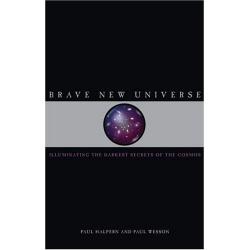 A steady progression of space borne and Earth-based telescopes bring long ago, far away events into our common perspective. We take these images, massage and arrange the hard won data, and, develop new interpretations of our existence and surroundings. Paul Halpern and Paul Wesson in their book Brave New Universe – Illuminating the Darkest Secrets of the Cosmos lay bare recent theories and postulations resulting from this. As they show, new information, when added to the mix, can as easily validate as confuse current prognoses.
A steady progression of space borne and Earth-based telescopes bring long ago, far away events into our common perspective. We take these images, massage and arrange the hard won data, and, develop new interpretations of our existence and surroundings. Paul Halpern and Paul Wesson in their book Brave New Universe – Illuminating the Darkest Secrets of the Cosmos lay bare recent theories and postulations resulting from this. As they show, new information, when added to the mix, can as easily validate as confuse current prognoses.
Knowledge of our cosmos in Greek times was little more than a concept of crystalline shells rotating about the central Earth orb. For these same Greeks, time was forever and beginnings were maybe 10,00 years previous and no ending was in sight. Today, we have a big bang beginning, consider negative times that might have come beforehand, and worry about big crunches or big freezes. As well, in wondering about the spatial dimensions, we’ve progressed past spheres and now contemplate universes that pop into and out of existence. Further, where people once only imagined three spatial and one temporal axis, we’re migrating into other realms, such as the branes with 11 surfaces. These ideas on space and time and the materials within are the elements of cosmology.
Halpern and Wesson’s book is cosmological. In it, there’s some history of astronomy, backgrounders in physics and a slight tinge of philosophy. But such is the state of cosmology; it’s much more than one simple subject. In accordance with this, the authors give the reader an abundance of historical background and current activity within this area of study. In a roughly chronological, historical order, they rebuild our database of knowledge. But, where a database is well ordered and linked, this book has a tendency to meander off to subjects, as the authors’ inclination or whim suggests. This is the danger with books on cosmology; the authors try to cover too much ground. Here, as the paragraphs and chapters get ever more detailed, the authors provide lots regarding the skies above but fail to present a cohesive rationale. Thus, their approach to illuminating secrets serves to weaken the idea of cosmology as a field of study rather than fill the reader with an understanding of its riches.
With the authors using this approach, they’ve erred. They’ve written a book about cosmology. But given the depth and breadth of their discussion, only other accomplished cosmologists will benefit from reading it. Yet, expectedly, most other cosmologists will be well initiated into the subject material. Hence, it’s a challenge identifying an appropriate audience for the book. Those who would benefit the most would be advanced undergraduates who have the basic understanding and skill but aren’t sure about their next direction of study.
With this consideration, there’s reason for the book seeming like a series of lectures or notes bound together. Each selection is well researched, supported with accreditation and written clearly. In an effort to avoid using equations, the authors talk the reader through some very simple algebra. However, this is another indication of confusion, as a few simple equations could have easily shown the intentions of a few paragraphs. In a further attempt to simplify the subject, the authors use many analogies. Some aid, some confuse. In consequence, this book, though current and accurate, is difficult to apply or find focus. Rather, from this book, the reader will get the impression that cosmology is an odd collection of strict math, conceptual physics, free wheeling philosophy and other advanced study areas. It’s an effort to read. There is some reward to the reading but it doesn’t come easily.
Cosmology is the answer to our questions about time and space. Better equipment and greater effort lifts our knowledge well past the bounds of what our eye can see. Paul Halpern and Paul Wesson in their book Brave New Universe – Illuminating the Darkest Secrets of the Cosmos take the reader to extremes. They show how far out our thinking keeps going in our quest for a greater understanding of our whereabouts.
Read more reviews online, or purchase a copy from Amazon.com
